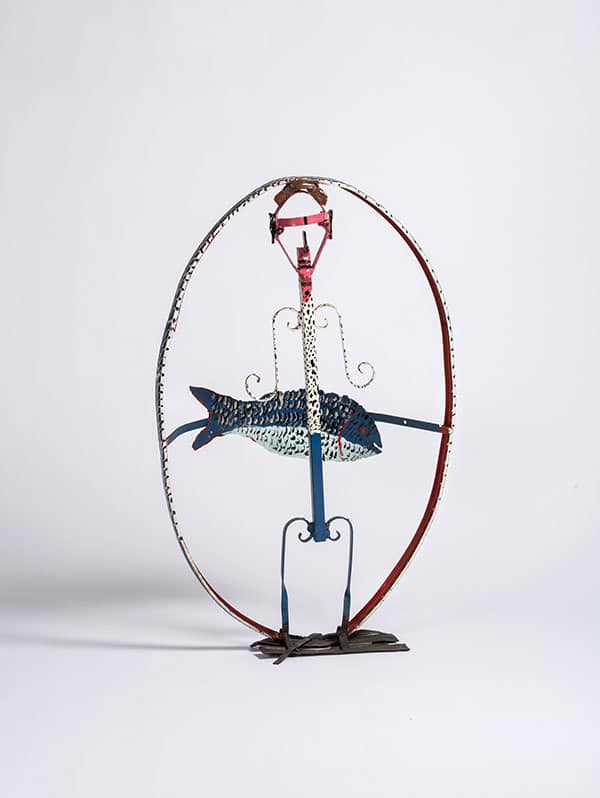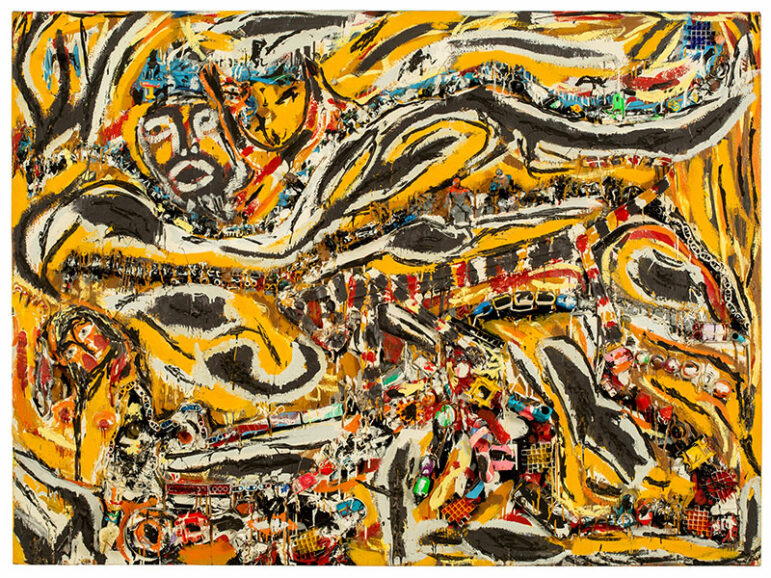Late Alabama artist Thornton Dial honored with first full-scale retrospective in his home state
By Rachel Parker, WBHM Reflect Alabama Fellow
As a child, Richard Dial can remember hearing his mother on the phone at two or three in the morning with their neighbor, asking him to try and get his father, Thornton Dial, to come inside from the backyard workshop after her own failed attempts. He was still busy creating art.
“Art was a part of his life,” Richard Dial said. “I think he really found his niche in life, his purpose in life,” Richard says.
Some of Thornton Dial’s pieces eventually made it into the nation’s top museums, including the Metropolitan Museum of Art in New York. But recognition of the Alabama-born artist by the larger art world did not come through a traditional path. Dial, who died in 2016, had little formal education and no art training.
Now, the University of Alabama at Birmingham’s Abroms-Engle Institute for the Visual Arts presents the first retrospective of Dial’s work in his home state. The exhibit, Thornton Dial: I, Too, Am Alabama, is open through Saturday.

One of the many jobs Dial worked throughout his life was as a metalworker at the Pullman Standard Plant in Bessemer, AL. From his different jobs, he sharpened his artistic skills and used materials he worked with daily, such as rope, wires, metal and fishing lures, to make art.
“I think that is a classic, prime example of some of his best works,” said Brandon Dial, Thornton Dial’s grandson. “When you’re taking things that people consider to be scraps and you’re turning it into something that is truly a treasure.”
In his popular piece called, “How Things Work: The Parade of Life,” two female figures made up of swirling colors – red, orange, black, yellow and white – spread across the canvas. Look closer and there’s a “parade” of children’s toys – cars and legos – lined up and attached to the painting. The objects appear to move through and around the women’s bodies.

“That’s the power of Mr. Dial’s work is that there is a lot of depth to it. There’s a lot of meaning behind it. Sometimes you can add your own meaning. Sometimes you know what his meaning is. It’s not just what the face value is like, what you see initially,” AEIVA Assistant Curator Tina Ruggieri said.
A rose and women were recurring symbols for Dial. They represent his relationship to the women in his life, since he was raised by his grandmother and aunts.
Dial’s artwork also reflects real world, complicated topics including politics, race, class and the environment.
“He would go to work, come home and eat. And he would always, always, every day, he would stop and watch the news. So he knew what was going on in the world,” Richard Dial said.
A timeline made up of plaques in the exhibit connects Dial’s life to contemporary historical events. For instance, the birth of his first child in 1953 is followed by the lynching of Emmett Till in 1955.
Dial wanted his art to be a force for change. He said to make that happen we should focus on the “little man,” which he described as people in the minority and lower class who are often forgotten, and their ideas.
“I see a lot of optimism in a lot of Thornton Dial’s work, even when he’s dealing with very difficult subject matter,.” said Paul Barrett, curator of the UAB exhibit.
While Dial gained widespread acclaim, Barrett says a show like this in Alabama is overdue.
“The fact that Thornton Dial’s work was not just recognized but celebrated in museums in New Orleans and Atlanta for many years before he was celebrated in his hometown, I think was a historic injustice that we were very happy to address,” Barrett said.
The University of Alabama at Birmingham holds WBHM’s broadcast license, but our news and businesses department operate independently.
Editor’s note: Story updated to attribute quote to AEIVA Assistant Curator Tina Ruggieri
How China, not the U.S., became the main climate solution story in 2025
The U.S. has become a "side character" in the global story of renewable energy, experts say. China dominates the sector, with positive implications for the climate and their economy.
Supreme Court to hear case that could vastly expand presidential powers
The Supreme Court hears arguments in a case about President Trump's firing of a Federal Trade Commissioner. At stake is a 90-year precedent limiting the president's power over independent agencies.
Republicans push high deductible plans and health savings accounts
A Republican call to give Americans cash instead of health insurance subsidies revives an old idea that has left millions with medical debt.
Zelenskyy heads to London for more Ukraine peace talks. Here’s what to know
The talks signal fresh support from European allies. But they follow stalled U.S. negotiations in Miami and comments from President Trump's son suggesting Washington is ready to pull back.
Tributes, not politics, play center stage as Trump hosts the Kennedy Center Honors
President Trump said he was closely involved with picking the honorees, and on Sunday he became the first president to host the Kennedy Center awards ceremony.
Thailand launches airstrikes along border with Cambodia as tensions reignite
Both sides accused the other of breaking a ceasefire that halted fighting earlier this year. Longstanding border disputes erupted into five days of combat in July that killed dozens.








